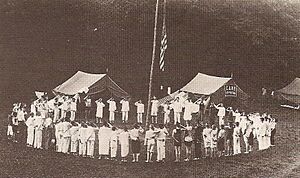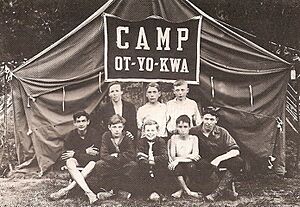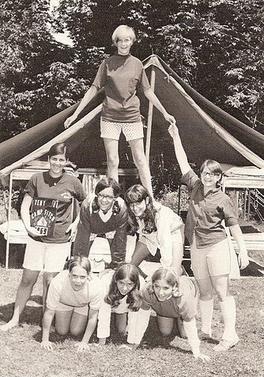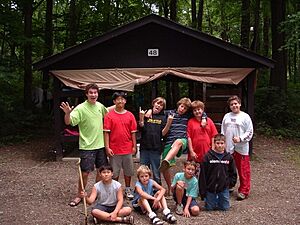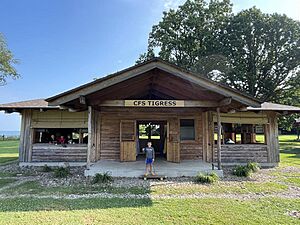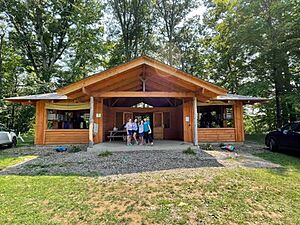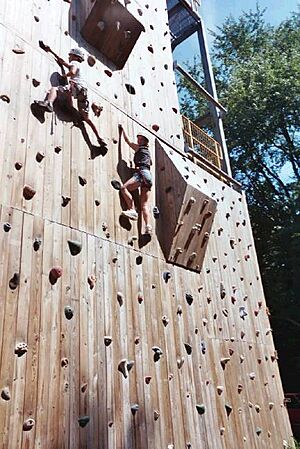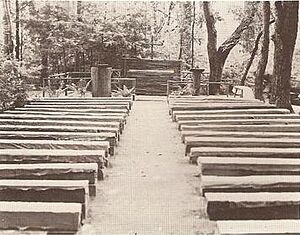YMCA Camp Fitch on Lake Erie facts for kids
Quick facts for kids YMCA Camp Fitch |
|
|---|---|
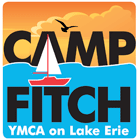
To help children grow in Spirit, Mind and Body
|
|
| Location | Springfield Township, Erie County, Pennsylvania, USA |
| Coordinates | 42°00′14″N 80°25′52″W / 42.004°N 80.431°W |
| Annual attendance | 19,000 |
| Established | 1914 |
YMCA Camp Fitch is an exciting year-round camp located in North Springfield, Pennsylvania. It's owned and run by the YMCA of Youngstown, Ohio. Before 1914, the YMCA of Youngstown had only temporary summer camps. But since it was founded in 1914, Camp Fitch has welcomed campers every single year! It started as a program of the YMCA's downtown branch, but now it's its own special part of the YMCA of Youngstown.
While it began as a camp just for summer, Camp Fitch can now operate all year long. This is thanks to a big effort to get more land and build more facilities, which started in the 1960s. During the summer, it's a traditional summer camp, with most campers staying for week-long adventures. When summer camp isn't happening, the camp runs an outdoor education program for schools. It also hosts many weekend groups and conferences.
Contents
Camp Fitch: A Look Back in Time
The Youngstown YMCA started hosting camps for young boys in the early 1900s. The very first one was at Muddy Lake in Ohio in 1906. In 1907, the camp moved to Grand River, and the next year it moved to a spot on Lake Erie.
In 1914, the YMCA decided to have a permanent summer camp for boys. The camp site that year was set up at Cannon's Mills on the Little Beaver River. Land for the camp was given by John H. Fitch, along with money to run the camp for five years. Thirty-two campers joined the first year. The camp stayed at this site for the summers of 1915, 1916, and 1917. Back then, campers often carried a forked stick for protection because there were many rattlesnakes and copperheads in the area. Luckily, this snake problem was solved when the camp moved!
In 1918, because more and more campers were joining, the camp moved to West Point, also on the Little Beaver River. After the 1918 summer, John H. Fitch's family gave $10,000 to buy the West Point camp site and make it better. The property had 26 acres (105,218 m2) of land and a lodge. The YMCA changed the camp's name from Ot-Yo-Kwa to Camp John H. Fitch to say thank you.
By 1923, the camp was full again with eight tents and one baseball field. A 93-acre (376,350 m2) site in North Springfield, Pennsylvania was chosen as the new permanent home for the camp. This wooded land was on Lake Erie, about 72 miles (116 km) from Youngstown. John H. Fitch's family helped again, giving $25,000 to buy this new site. In 1924, on Camp Fitch's tenth anniversary, the camp moved to its current location. The new site had many acres of woods and a half-mile (800 m) of beachfront.
At the new site, the camp focused on its programs. It had a doctor, a chaplain, and directors for crafts, nature study, and waterfront activities. There were also village directors for each of the three age groups: Windy City (ages 9-11), Chicagami (ages 12-14), and Ot-Yo-Kwa (ages 15 and older). Each tent had a leader.
Camp Fitch was only for boys until the summer of 1951, when a two-week program for girls started. This was very popular, so more girl-only periods were added in the following years. By 1957, so many boys and girls wanted to come that the camp needed to run a girls' camp and a boys' camp at the same time. The girls' camp (Chicagami) used the original camp area. A new area of forest was cleared for the new boys' camp, Ot-Yo-Kwa.
In the mid-1960s, Camp Fitch became an official YMCA branch. It then started a huge expansion of its buildings and programs that lasted for many years. Under the leadership of William Lyder, Fitch grew from a summer-only camp to a permanent, year-round place, open about 340 days a year. Existing buildings were updated to be used in winter. These upgrades, plus two new outdoor education lodges, allowed for the start of an Outdoor Education program in 1973. This program serves schools and youth groups when summer camp is not in session. During the outdoor education season, Fitch's staff work with visiting teachers to teach about the area's history, geography, and nature. With these year-round programs, about 19,000 campers visit the camp each year.
As more programs were added, Fitch needed more land. In the early 1970s, the camp bought 284 acres (1.1 km2) of wooded flatland and a half-mile of Lake Erie shoreline. The camp's eastern border also expanded to follow Crooked Creek. In 1984, the French Creek Boy Scout Council sold its Camp Sequoyah, which was just east of Camp Fitch. Fitch bought all of Sequoyah south of Ables Road, plus 300 feet (91 m) of lakefront property. This made the camp its current size of over 450 acres (1.8 km2) with 1 mile (1.6 km) of Lake Erie frontage. So far, only about 90 acres (364,217 m2) of the camp land have been developed. The rest is untouched wilderness, used for outdoor programs, hiking trails, and a natural buffer.
Besides expanding the land, William Lyder also worked to add more facilities for campers. A pool and an inland lake were built to make the water programs better. All bathrooms were updated, and several living lodges were built. Program areas got roofs to protect campers from snow and rain, and a 40-foot (12 m) climbing tower was built. The biggest changes during his time were the creation of cabents and a new Dining Hall. With the new dining hall, the camp could feed 1000 guests at once. With these new features, Fitch has recently started hosting company retreats and conferences all year.
Camp Fitch Today
Cabents (1986 to Present)
Camp Fitch used to house campers in tents for a long time. But by 1986, it was getting too expensive to fix the canvas tents, and they weren't very convenient. So, the "cabent" was invented! A cabent is a mix of a tent and a cabin. It has a strong wooden roof with big corner posts and canvas sides built over a concrete floor. Cabents let the camp keep its outdoor, tent-style camping feel, but without the old problems. Each cabent usually fits eight people: one counselor and seven campers. In the early 2000s, most cabents got built-in bunk beds, so staff didn't have to move beds around anymore. Cabents housed most campers from 1986 to 2017. Today, they are used for campers aged 14 and older.
Cabins (2017 to Present)
In 2017, the camp decided to upgrade its main housing from cabents to larger cabins. These new cabins have a special design. They keep the "open air meets enclosed structure" feel of the cabents but also have features found in traditional cabins. The cabins are built on a large foundation with strong wooden posts and beams. They have two separate sections for campers and staff. The sleeping areas are almost twice as big as cabents, and more staff can stay with the campers, making supervision better. To keep the open-air feel, a large part of each outside wall is open, allowing a cool breeze from Lake Erie to flow through. If the weather is bad, special siding can be rolled down over the open areas, just like with the cabents. As of 2024, Camp Fitch has built 16 cabins to house all campers under age 13. They plan to build at least 26 in total.
These new cabins also offer more modern comforts that cabents and tents couldn't provide. A common area between the sleeping sections has a half bathroom and private changing rooms. There are two covered, open-air porches at the front and back of the cabins. Plus, permanent walls along the foundations keep the cabins dry during wet weather.
International Programs
For many years, people from all over the world have been part of the staff and volunteers at Camp Fitch. This tradition started in 1972 when a registered nurse from Switzerland joined the staff through a YMCA program. For the next ten years, the camp hosted a few international staff members each year. But in 1984, Camp Fitch was able to bring in even more staff from other countries. This was mainly because of a strong connection between YMCA España (YMCA Spain) and several YMCAs in Northern Ohio. This partnership first led to a small staff exchange program between the two countries. By 1987, Camp Fitch's counselor-in-training program started actively inviting both Spanish and American young people to join.
Today, Camp Fitch still works closely with YMCA España and other international partners. They help arrange international camping experiences for kids and young adults from other countries. Every year, Fitch welcomes several international staff members, campers, and CITs (Counselors-in-Training).
Fun Facilities and Activities
Camp Fitch has awesome facilities for tons of fun! These include a 4-story climbing tower with a zip line, an indoor climbing center, a rifle range, an archery range, and a swimming pool. You can also find mountain bike trails, horseback riding, an air-rifle range, and an indoor nature activity center. There's an inland lake called Lake MVIMA, and you also have access to Lake Erie!
Activities include: Horseback Riding, Air-Rifles, Rock Climbing, Swimming, Sailing, Crafts, Canoeing, Boating, Water-skiing, Archery, Riflery (with .22 mm rifles), Rocketry, Horsemanship Lessons, Campfires, Swim Lessons, Stand-Up Paddleboarding (SUP), and daily programs just for your age group.
Fleets: Your Camp Crew!
During the summer, campers are divided into different age groups called "fleets." Each fleet's cabents or cabins are grouped together on the camp grounds. Your fleet also sits together in the dining hall. Every fleet has its own songs and traditions. Throughout the week, campers get to join in special fleet-only programs made just for their age level.
In Camp Chicagami (Girls' Camp), the age groups are:
- Sloop fleet (ages 8 to 10)
- Schooner fleet (ages 11 to 12)
- Clipper fleet (ages 13 to 14)
- Galleon Fleet (ages 15 to 16)
Camp Ot-Yo-Kwa (Boys' Camp) is divided as follows:
- Sloop Fleet (ages 8 to 10)
- Schooner Fleet (ages 11 to 12)
- Clipper Fleet (ages 13 to 14)
- Galleon Fleet (ages 15 to 16)
Both Girls' Camp and Boys' Camp have a Mackinaw Fleet (ages 6 to 7). This is a special "first" camp designed to introduce younger children to summer camping.
Specialty Camps
Besides the regular summer camp program, Camp Fitch also offers several "specialty" camps. These programs usually have a special theme or goal. Most of them still let campers take part in the traditional camp activities during their stay. Specialty camps are generally grouped into three categories:
Leadership and Development Fleets Camp Fitch has two programs to help future staff members learn leadership skills. Their Counselor in Training (CIT) program, for high school juniors, is well-known for training young people from different countries and helping them find jobs at Camp Fitch and other summer camps. The Leaders in Training (LIT) program is for high school sophomores to learn basic leadership skills that they can use at camp and at home.
Focus Programs Focus Programs include all the fun of traditional camp, plus extra activities led by experts in that special area. At the Camp Fitch Farm, campers can choose Farm Focus, where they learn about different kinds of farm animals. Outriders focuses on horseback riding programs. Tech Focus at Camp Fitch includes Drone Camp and one of the oldest computer camps in the country. Besides these activity camps, the camp also hosts programs for kids with Diabetes and Camp Frog for epilepsy during the summer.
Teen Adventure Trips Every summer, Camp Fitch offers several multi-week camping trips away from the main camp. These trips often include hiking, white water rafting, caving, and rock climbing across the eastern United States.
Camp Fitch's Spiritual Mission
The idea for Camp Fitch came from the "need of the city boy for a vacation in the out-of-doors under Christian leadership." Today, Fitch's mission matches the YMCA's goal: "helping children grow in spirit, mind and body." While campers and staff from many different beliefs come to camp all year, Christian education and leadership are still a core part of the camp's mission. Camp staff are expected to "lead by example" by acting in a Christian way at all times. To help with this, the camp holds a Christian Leadership Conference once a year for YMCA staff and volunteers. Camp Fitch has special places on its grounds for spiritual activities, including two outdoor chapels, one indoor chapel, and quiet reflection spots for both the Girls' and Boys' camps.
During the summer, campers attend daily chapel services and a midweek Vespers service. However, most people who have been to Camp Fitch agree that the most special spiritual moment of the summer is the unique Candlelight service held at the end of each week. This service was written by Raymond L. "Curly" Johnson, who was Fitch's director from 1928 to 1935. It combines lessons about building good character with Christian themes. Johnson originally led the service himself for campers, and the version used today has changed very little. At the end of the service, everyone is asked to set a personal goal to work on when they leave Camp Fitch. In 1982, to honor Johnson and his impact on Fitch's spiritual history, the camp chapel was renovated and renamed "Curly's Chapel."
Affiliations
Camp Fitch is a proud member of the American Camp Association.


